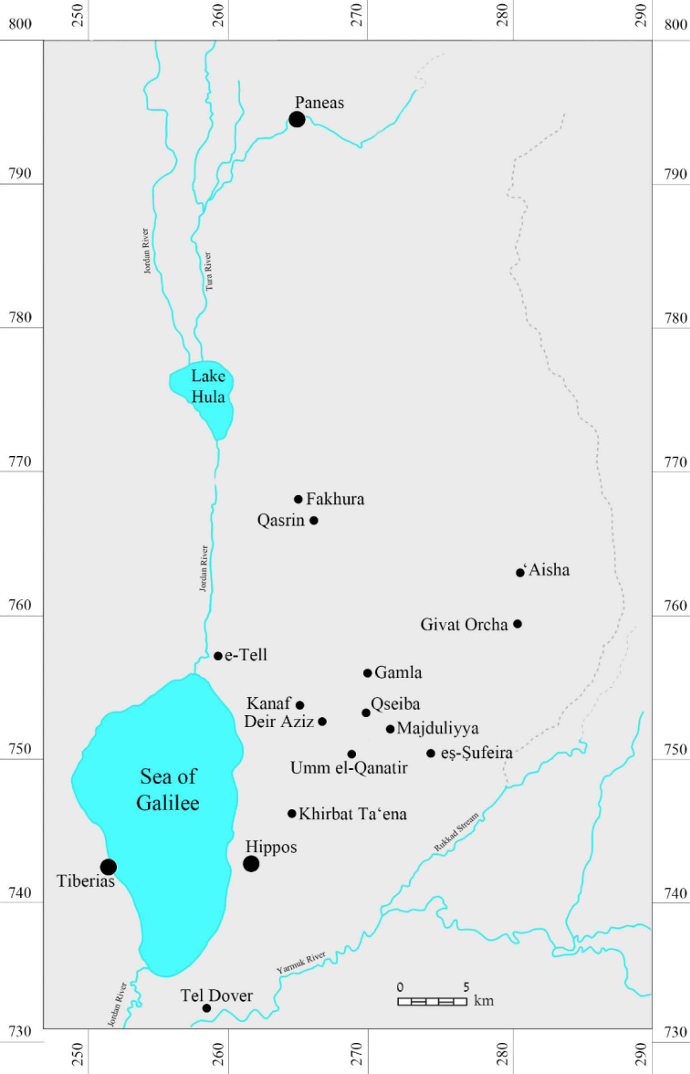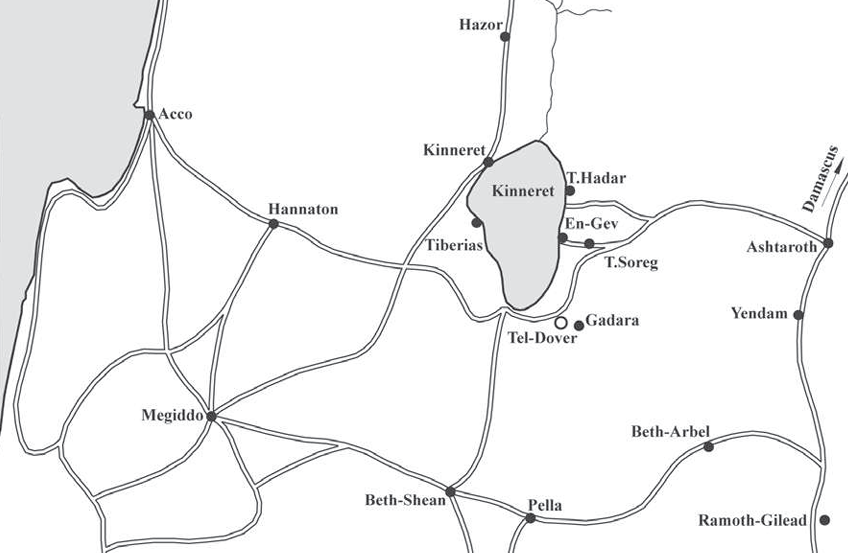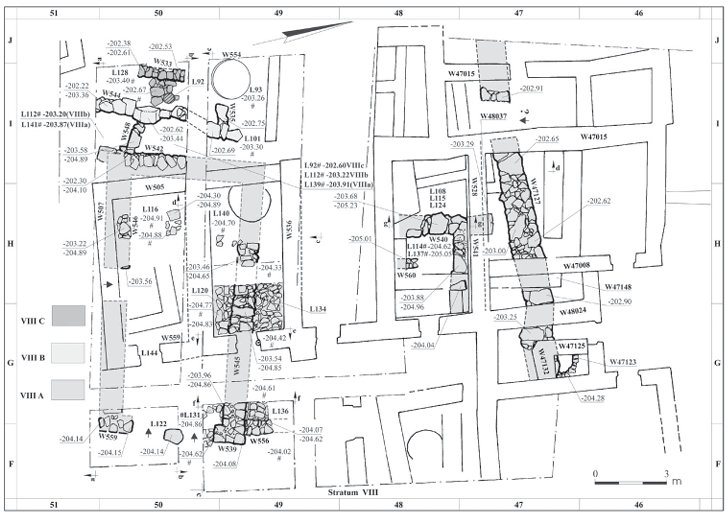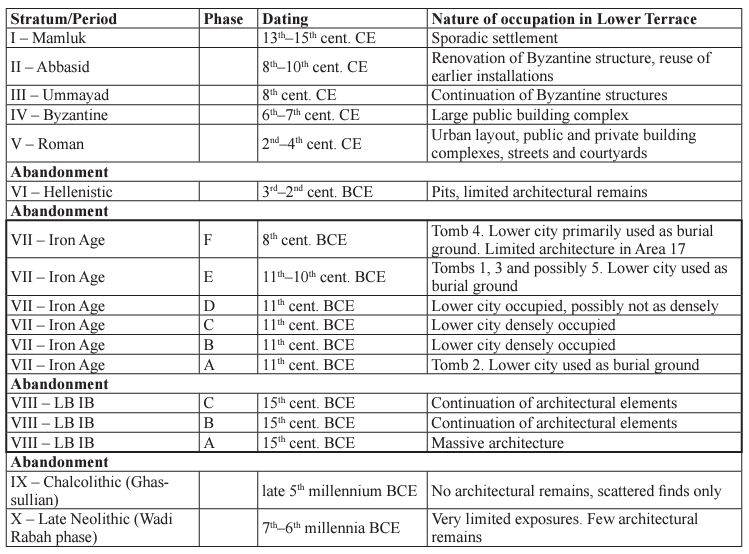Tel Dover
 Figure 2
Figure 2The lower terrace of the tell, wedged in between the Yarmuk River on the left and a local basalt cliff on the right, looking south-west. Note the smaller tell or acropolis, centre right
Golani and Wolff (2016)
| Transliterated Name | Source | Name |
|---|---|---|
| Tel Dover | Hebrew? | |
| Tel Dober | Hebrew? | |
| Khirbet ed Duweir | Arabic | |
| Tall al Mudawwarr | Arabic |
Tel Dover is located in northern Israel, south of the Sea of Galilee and near the southern tip of the Golan Heights, known in Egyptian texts as the land of Geshur. The site lies on the northern bank of the Yarmuk River to the north-east of its confluence with the Jordan River, both of which form the international border between Israel and Jordan. Tel Dover is not far from other well-known and excavated sites such as Gadara (Umm Qeis) in Jordan and Tel Hadar, Hammat Gader and ‘Ein Gev in Israel (Fig. 1).
The site lies close to abundant farmland and has a perennial freshwater source. It is strategically located on inter-regional routeways including those leading from Beth Shean to Ashtaroth and Damascus. During the Roman period the roads leading to Gadara from Beth Shean-Scythopolis or Tiberias would have passed close to the site and it is probable that the same roads were in use in earlier periods as well.
The site consists of a small tell or acropolis, approximately 5 dunams in size, with an extensive lower city covering approximately 20 dunams to its south-east. This was bounded by the Yarmuk River to the east and a basalt cliff to the west (Fig. 2). The acropolis itself has been surveyed but not excavated and has yielded material primarily of the Middle Bronze, Late Bronze, Iron Age II and Roman periods. As the site lies within a restricted military area, access to it is limited.
Following the Israeli-Jordanian peace negotiations in 1997, a scheme involving the construction of a dam across the Yarmuk River close to the site was proposed. Because the site of Tel Dover is located on the Israeli side of the border, this proposal necessitated a large-scale rescue excavation which was undertaken by the Israel Antiquities Authority under the direction of the late Alexander Onn. The excavation focused on the terrace occupied by lower city, although the tell itself and the immediate environs of the site were also surveyed. The dam was eventually built at another location and the site remains intact. The full publication of the rescue project is in preparation (for a preliminary note, see Rapuano 2001).
The excavations identified ten phases of occupation on the lower terrace (Fig. 3), although it remains to be seen if all these periods and/or others are also represented on the acropolis. Occupation on the terrace was intermittent and included periods of intense occupation followed by periods of abandonment and resettlement.
- Fig. 1 - Location Map
from Eisenberg and Osband (2022)

 Figure 1
Figure 1
Map with sites mentioned in the text
(D. Shalem and M. Eisenberg)
Eisenberg and Osband (2022) - Fig. 1 - Location Map
from Golani and Wolff (2016)

 Figure 1
Figure 1
General location map of Tel Dover
Golani and Wolff (2016)
- Fig. 2 - Aerial View
from Golani and Wolff (2016)

 Figure 2
Figure 2
The lower terrace of the tell, wedged in between the Yarmuk River on the left and a local basalt cliff on the right, looking south-west. Note the smaller tell or acropolis, centre right
Golani and Wolff (2016) - Tel Dover in Google Earth
- Tel Dover on govmap.gov.il
- Fig. 4 - Remains of the
Late Bronze Age Stratum VIII from Golani and Wolff (2016)

 Figure 4
Figure 4
Remains of the Late Bronze Age Stratum VIII in the south-western portion of the terrace
Golani and Wolff (2016)
- Fig. 4 - Remains of the
Late Bronze Age Stratum VIII from Golani and Wolff (2016)

 Figure 4
Figure 4
Remains of the Late Bronze Age Stratum VIII in the south-western portion of the terrace
Golani and Wolff (2016)
 Fig. 3
Fig. 3The archaeological periods of settlement revealed through the excavation of the lower terrace at Tel Dover
Golani and Wolff (2016)
 Fig. 13
Fig. 13Comparative stratigraphy and chronology of Tel Dover with other sites of the region
Golani and Wolff (2016)
Eisenberg and Osband (2022) report that Rapuano (2001) identified
an early 4th century CE destruction layer which could have been due to the
Eusebius Martyr Quake (between ~303 and ~306 CE).
Tel Dover is a large site where large-scale excavations were conducted but have not been finally published. It is unclear whether the site is located within the southern edges of Hippos Territorium or whether it belonged to Gadara like the nearby site of Hamat Gader,just 4 km to the east (Pazout and Eisenberg 2021). A destruction layer was dated to the beginning of the 4th century, perhaps due to the 303 CE earthquake (Rapuano 2001).36 The site continued into the Byzantine period as well as the Early Muslim period. It seems that the 363 and 749 earthquakes did not end settlement at the site.
36 The excavators mention a 306 CE earthquake but that quake is considered by most scholars today to have occurred in 303 CE, as do we in this article (Zohar, Salamon and Rubin 2017: 4).
Eisenberg, M. and Osband, M. (2022) Evidence for Settlement Decline in Late 3rd–mid-4th Centuries CE in the Hippos Region and Beyond,
Aram v. 34:1 & 2, 153-184
Golani, A. and Wolff, Samuel R. (2016) The Late Bronze I and Iron Age I Remains at Tel Dover in the Jordan Valley, Israel
in Proceedings of the 10th International Congress on the Archaeology of the Ancient Near East Volume 2
Khalaily, Hamoudi, Milevski, Ianir, Horwitz, Liora Kolska, and Marder, Ofer (2016) Early Wadi Rabah and Chalcolithic Occupations at Tel Dover: Environmental and Chronlogical Insights
in From Sha‘ar Hagolan to Shaaraim Essays in Honor of Prof. Yosef Garijinkel Israel Exploration Society
Rapuano, Y. (2001). Tel Dover.
Hadashot Arkheologiyot: Excavations and Surveys in Israel (Hebrew) - at JSTOR

